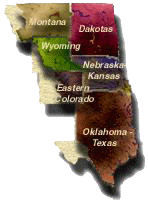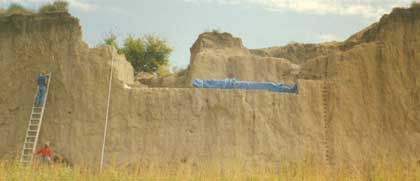Environment and Cultural Resources:
Welcome to the Great Plains Region's Environment and Cultural Resources page. This section of our Web site is designed to provide an overview of our environmental programs and links more information about ongoing environmental actions the Great Plains Region. You may use the map to the right to navigate to any of GP's six area offices, where you can find information about local public meetings and other events. To return to this page please select Environment and Cultural Resources from the left menu. The Great Plains Region encompasses all or parts of nine states, and is the most environmentally and culturally diverse area managed by the Bureau of Reclamation. The Region has has approximately 128 species listed under the Endangered Species Act, and a host of other cultural and archeological resources. The page below is divided into three major sections, each addressing an area related to environmental compliance:
|
|||||
National Environmental Policy Act (NEPA) - <back to top> NEPA was enacted in 1969 to declare the Nation’s policy on protection of the environment. NEPA requires Federal agencies to use all practicable means within their authority to protect the environment, and establishes a process for analyzing and disclosing the impacts of Federal actions on the environment. The Act also established the Council on Environmental Quality (CEQ) to oversee and advance the goals of NEPA. NEPA's objective is to improve Federal decision-making through early involvement of the public and Federal, state, tribal, and local agencies in the planning process and through disclosure of the impacts associated with proposed actions and alternatives. To assist Federal agencies achieve this objective, the CEQ developed regulations and guidance for implementing NEPA that outline the analytical and disclosure processes for environmental impact statements (EIS), environmental assessments, and categorically-excluded actions (CE). For more information on NEPA, please view our NEPA PowerPoint presentation.
|
|||||
 |
|||||
NOTE: Some files require Adobe Acrobat Reader--Download here! |
|||||
Endangered Species Act (ESA) - <back to top> Section 7(a)(1) of the ESA requires Interior agencies to utilize programs administered by the Secretary to further the purposes of the ESA and other federal agencies to utilize their authorities to further the purposes of the ESA by carrying out programs for the conservation of listed species. Such actions are considered to be voluntary conservation measures. Section 7(a)(2) is action-forcing and requires federal agencies consult with the Secretary to insure that any action authorized, funded, or carried out by such agency is not likely to jeopardize the continued existence of listed species or result in destruction or adverse modification of critical habitat. It is through this consultation process that Reclamation assesses the effects of its actions and the Fish and Wildlife Service determines whether such actions are likely to jeopardize the continued existence of listed species or adversely modify designated critical habitat. Listed species in the Great Plains Region range from large, well-known vertebrates such as the grizzly bear, whooping crane, and bald eagle to relatively obscure species like the American burying beetle, pallid sturgeon, and cave-dwelling invertebrates. Species that are proposed for listing are not formally protected by the ESA but are treated similarly to listed species during consultations where they may be present in the action area. The Great Plains Region normally considers potential effects on candidate species (not currently listed, but information exists that may warrant future listing) that may be present in the action area to minimize adverse effects and avoid the need for future listing. For most actions, the section 7 consultation process is incorporated into our NEPA compliance process.
|
|||||
|
|||||
NOTE: Some files require Adobe Acrobat Reader--Download here! |
|||||
Fish and Wildlife Coordination Act – The predecessor to the Fish and Wildlife Coordination Act (FWCA) wasenacted in 1934 as one of the Nation’s first wildlife conservation laws. Several revisions followed, and in 1958, the law was first referred to by its current title. Along with other requirements, the FWCA requires federal agencies proposing to modify a waterbody to consult with the Fish and Wildlife Service and provide equal consideration for fish and wildlife resources in project planning. Fish and Wildlife Coordination Act – you can view the text of the FWCA through this link |
|||||
|
|||||
NOTE: Some files require Adobe Acrobat Reader--Download here! |
|||||
National Historic Preservation Act (NHPA)- <back to top> Section 106 and its implementing regulations, 36 CFR Part 800, directs Federal agencies to follow a consultation process in assessing the affects of Federal undertakings on historic properties (properties included in or eligible for inclusion in the National Register of Historic Places).
Historic properties can be archaeological sites, buildings, structures (even Reclamation built structures such as dams and canals), and sites of traditional religious and cultural importance to an Indian tribe. Federal agencies must identify historic properties that may be affected by a Federal undertaking, determine if the properties are eligible for the National Register, and address any adverse effects to those properties. The Section 106 consultation process should include the State Historic Preservation Officer or Tribal Historic Preservation Officer or both, project proponents or applicants for Federal assistance, permits, licenses or other approvals, local governments and interested members of the public.
Archaeological Resources Protection Act (ARPA) – <back to top> ARPA prohibits the removal of archaeological materials from Federal lands without a permit issued by the managing agency. Violators are subject to prosecution and possible fine or imprisonment. Before issuing a permit for archaeological excavation Federal agencies must consult with any Indian tribes which consider the archaeological site to have religious or cultural importance. ARPA also directs Federal agencies to educate the public about archaeological resources, and to survey their lands for archaeological resources. The implementing regulations for ARPA are 43 CFR Part 7.
Native American Graves Protection and Repatriation Act (NAGPRA) – <back to top> Anyone who inadvertently discovers Native American Human remains, funerary objects, sacred objects or objects of cultural patrimony on Federal lands must immediately notify the Federal land manager by telephone and provide written confirmation. If the discovery was made in conjunction of some activity being conducted on Federal land, the activity must be stopped in the area of the discovery and reasonable efforts made to protect the materials. The Federal agency must notify the Indian tribes likely to be affiliated with the discovery, and develop a written agreement with affiliated tribes for excavation or removal of the remains if they cannot be left in place. Federal agencies must also inventory Native American human remains and associated funerary objects that were in the Federal agency’s collections prior to November 1990, and repatriate the remains to the affiliated tribes if affiliation can be determined.
|






